Strategic Analysis of Oman Flour Mills: Industry and Company
VerifiedAdded on 2021/05/27
|24
|5563
|660
Report
AI Summary
This report provides a comprehensive strategic analysis of Oman Flour Mills, examining its external and internal environments. The analysis begins with an overview of the company and its mission and vision statements. The external environment is assessed using PESTEL and Porter's Five Forces analyses, providing insights into the political, economic, social, technological, environmental, and legal factors impacting the company, as well as the competitive dynamics within the industry. The internal environment is evaluated through SWOT and VRIO analyses, identifying the company's strengths, weaknesses, opportunities, and threats, as well as its resources and capabilities. Value chain analysis and a discussion of key strategies are also included. The report concludes with strategic recommendations for Oman Flour Mills to enhance its market position and achieve its goals. The company's performance, market share, and competitive landscape are also discussed throughout the report. The report also presents the company's brands like Dahabi and Barakar Feeds, and its financial performance, including net profit after tax.
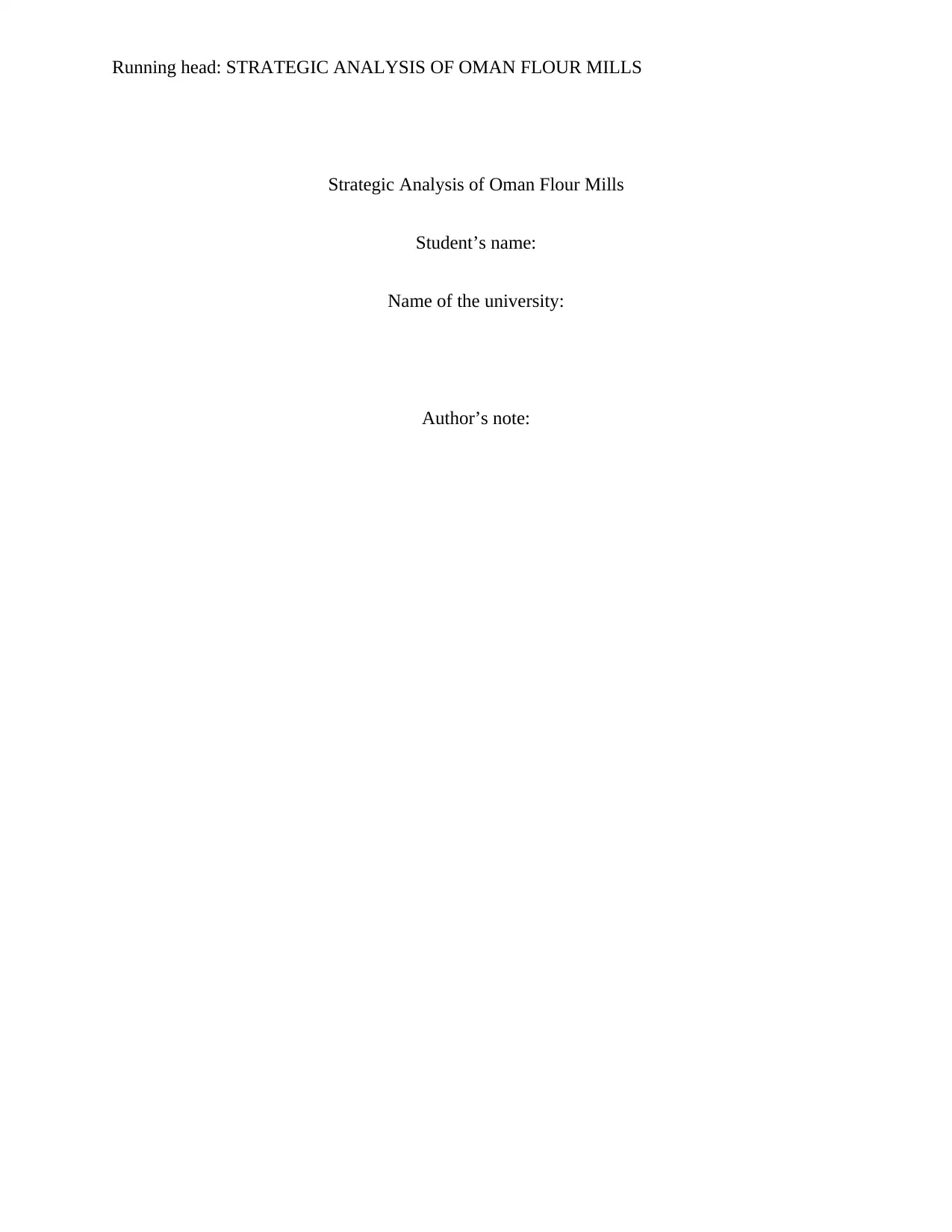
Running head: STRATEGIC ANALYSIS OF OMAN FLOUR MILLS
Strategic Analysis of Oman Flour Mills
Student’s name:
Name of the university:
Author’s note:
Strategic Analysis of Oman Flour Mills
Student’s name:
Name of the university:
Author’s note:
Paraphrase This Document
Need a fresh take? Get an instant paraphrase of this document with our AI Paraphraser
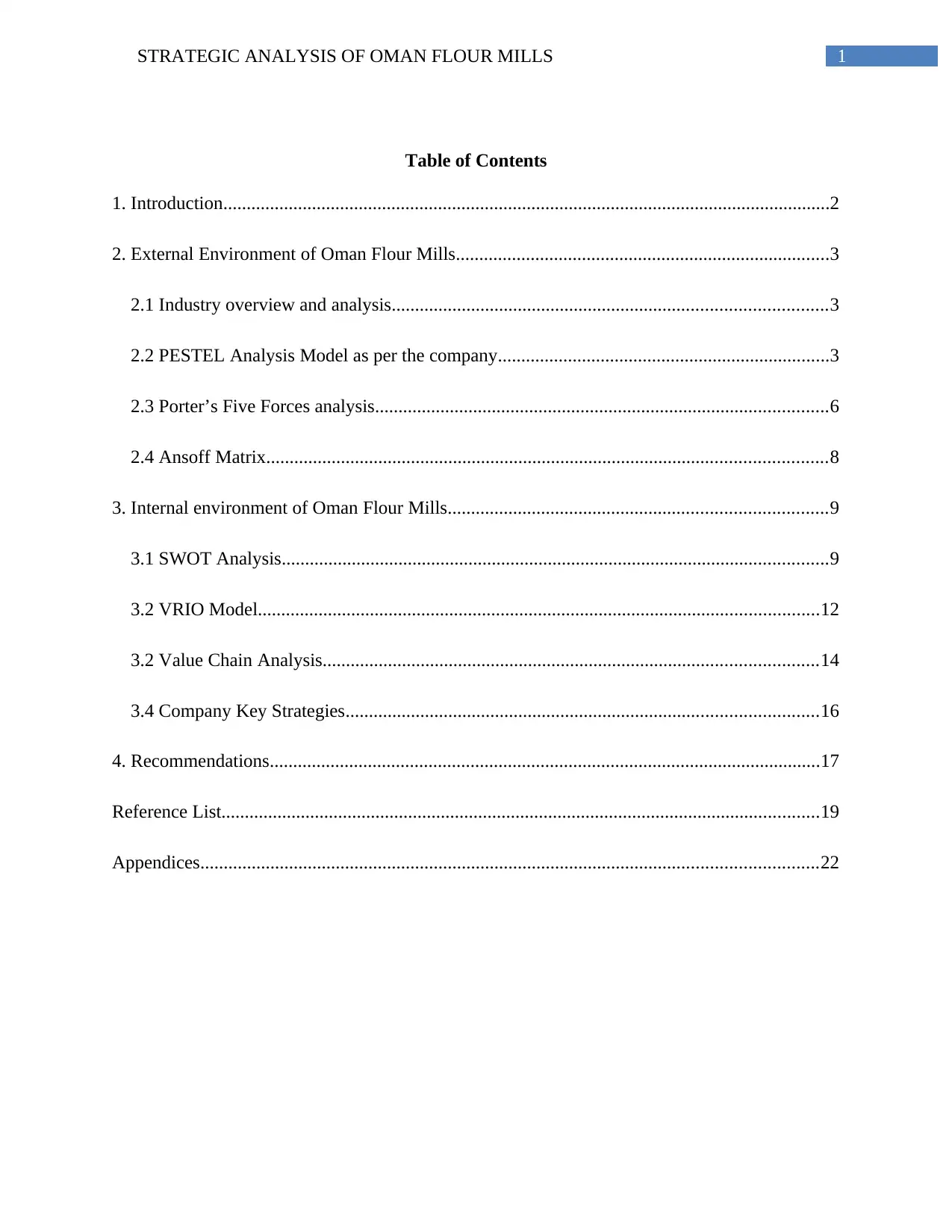
1STRATEGIC ANALYSIS OF OMAN FLOUR MILLS
Table of Contents
1. Introduction..................................................................................................................................2
2. External Environment of Oman Flour Mills................................................................................3
2.1 Industry overview and analysis.............................................................................................3
2.2 PESTEL Analysis Model as per the company.......................................................................3
2.3 Porter’s Five Forces analysis.................................................................................................6
2.4 Ansoff Matrix........................................................................................................................8
3. Internal environment of Oman Flour Mills.................................................................................9
3.1 SWOT Analysis.....................................................................................................................9
3.2 VRIO Model........................................................................................................................12
3.2 Value Chain Analysis..........................................................................................................14
3.4 Company Key Strategies.....................................................................................................16
4. Recommendations......................................................................................................................17
Reference List................................................................................................................................19
Appendices....................................................................................................................................22
Table of Contents
1. Introduction..................................................................................................................................2
2. External Environment of Oman Flour Mills................................................................................3
2.1 Industry overview and analysis.............................................................................................3
2.2 PESTEL Analysis Model as per the company.......................................................................3
2.3 Porter’s Five Forces analysis.................................................................................................6
2.4 Ansoff Matrix........................................................................................................................8
3. Internal environment of Oman Flour Mills.................................................................................9
3.1 SWOT Analysis.....................................................................................................................9
3.2 VRIO Model........................................................................................................................12
3.2 Value Chain Analysis..........................................................................................................14
3.4 Company Key Strategies.....................................................................................................16
4. Recommendations......................................................................................................................17
Reference List................................................................................................................................19
Appendices....................................................................................................................................22
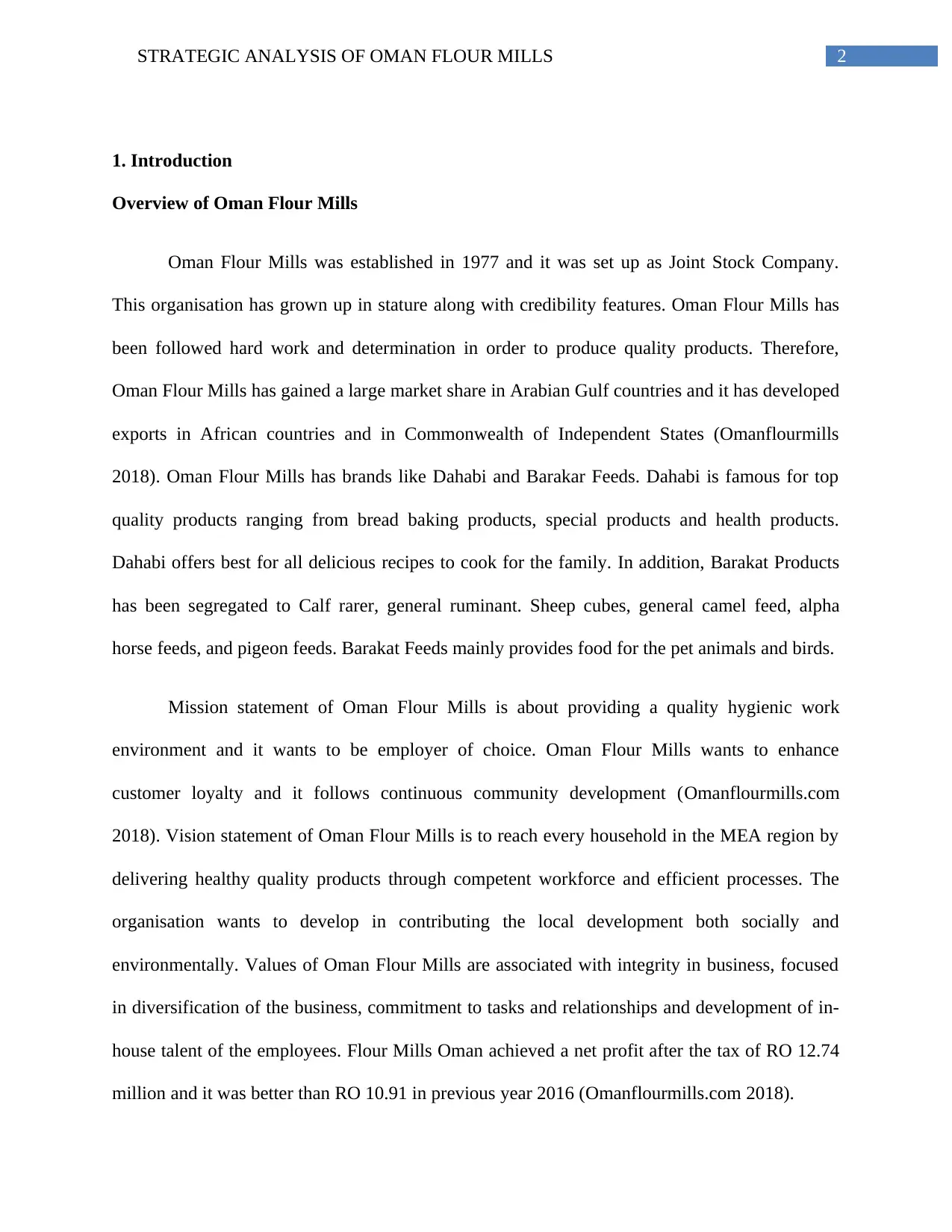
2STRATEGIC ANALYSIS OF OMAN FLOUR MILLS
1. Introduction
Overview of Oman Flour Mills
Oman Flour Mills was established in 1977 and it was set up as Joint Stock Company.
This organisation has grown up in stature along with credibility features. Oman Flour Mills has
been followed hard work and determination in order to produce quality products. Therefore,
Oman Flour Mills has gained a large market share in Arabian Gulf countries and it has developed
exports in African countries and in Commonwealth of Independent States (Omanflourmills
2018). Oman Flour Mills has brands like Dahabi and Barakar Feeds. Dahabi is famous for top
quality products ranging from bread baking products, special products and health products.
Dahabi offers best for all delicious recipes to cook for the family. In addition, Barakat Products
has been segregated to Calf rarer, general ruminant. Sheep cubes, general camel feed, alpha
horse feeds, and pigeon feeds. Barakat Feeds mainly provides food for the pet animals and birds.
Mission statement of Oman Flour Mills is about providing a quality hygienic work
environment and it wants to be employer of choice. Oman Flour Mills wants to enhance
customer loyalty and it follows continuous community development (Omanflourmills.com
2018). Vision statement of Oman Flour Mills is to reach every household in the MEA region by
delivering healthy quality products through competent workforce and efficient processes. The
organisation wants to develop in contributing the local development both socially and
environmentally. Values of Oman Flour Mills are associated with integrity in business, focused
in diversification of the business, commitment to tasks and relationships and development of in-
house talent of the employees. Flour Mills Oman achieved a net profit after the tax of RO 12.74
million and it was better than RO 10.91 in previous year 2016 (Omanflourmills.com 2018).
1. Introduction
Overview of Oman Flour Mills
Oman Flour Mills was established in 1977 and it was set up as Joint Stock Company.
This organisation has grown up in stature along with credibility features. Oman Flour Mills has
been followed hard work and determination in order to produce quality products. Therefore,
Oman Flour Mills has gained a large market share in Arabian Gulf countries and it has developed
exports in African countries and in Commonwealth of Independent States (Omanflourmills
2018). Oman Flour Mills has brands like Dahabi and Barakar Feeds. Dahabi is famous for top
quality products ranging from bread baking products, special products and health products.
Dahabi offers best for all delicious recipes to cook for the family. In addition, Barakat Products
has been segregated to Calf rarer, general ruminant. Sheep cubes, general camel feed, alpha
horse feeds, and pigeon feeds. Barakat Feeds mainly provides food for the pet animals and birds.
Mission statement of Oman Flour Mills is about providing a quality hygienic work
environment and it wants to be employer of choice. Oman Flour Mills wants to enhance
customer loyalty and it follows continuous community development (Omanflourmills.com
2018). Vision statement of Oman Flour Mills is to reach every household in the MEA region by
delivering healthy quality products through competent workforce and efficient processes. The
organisation wants to develop in contributing the local development both socially and
environmentally. Values of Oman Flour Mills are associated with integrity in business, focused
in diversification of the business, commitment to tasks and relationships and development of in-
house talent of the employees. Flour Mills Oman achieved a net profit after the tax of RO 12.74
million and it was better than RO 10.91 in previous year 2016 (Omanflourmills.com 2018).
⊘ This is a preview!⊘
Do you want full access?
Subscribe today to unlock all pages.

Trusted by 1+ million students worldwide
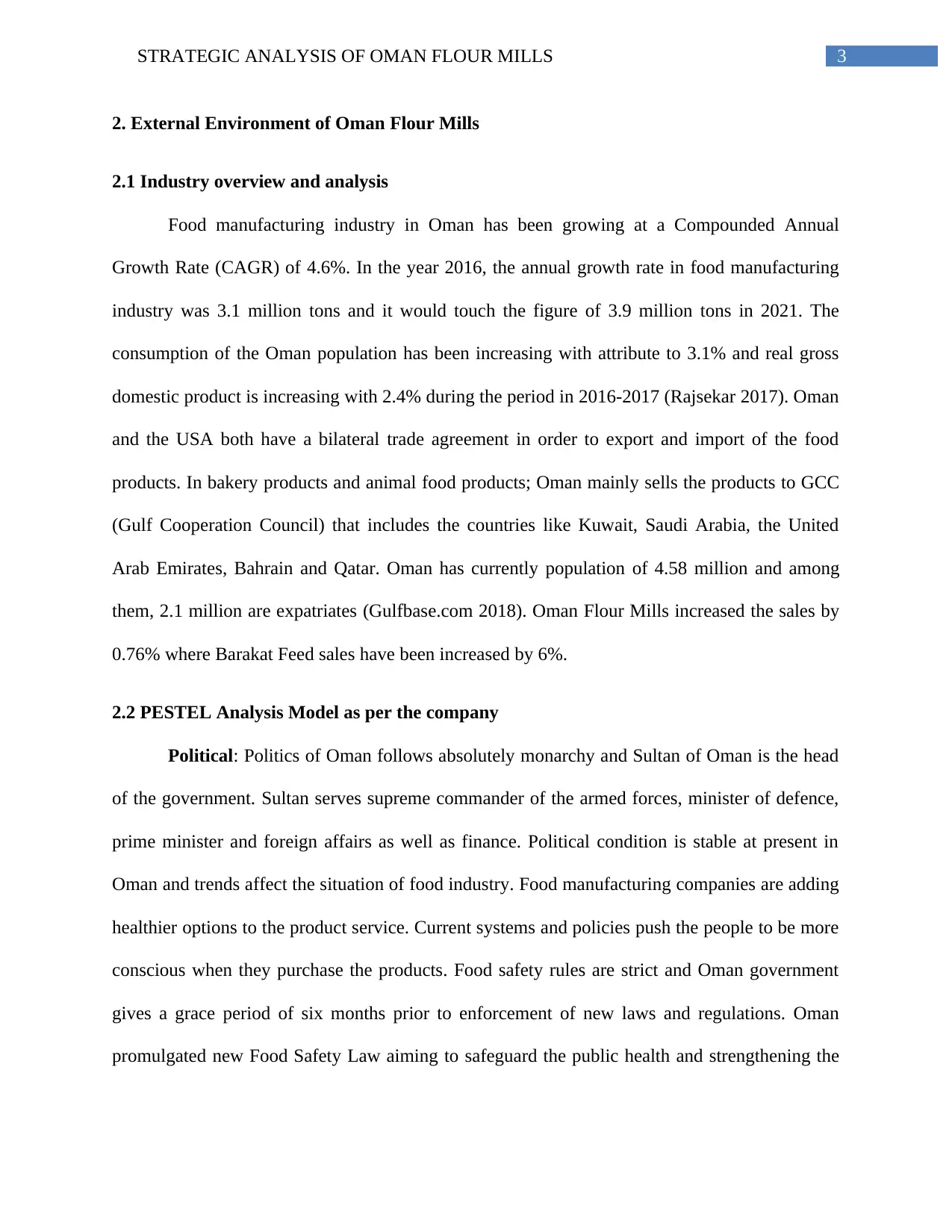
3STRATEGIC ANALYSIS OF OMAN FLOUR MILLS
2. External Environment of Oman Flour Mills
2.1 Industry overview and analysis
Food manufacturing industry in Oman has been growing at a Compounded Annual
Growth Rate (CAGR) of 4.6%. In the year 2016, the annual growth rate in food manufacturing
industry was 3.1 million tons and it would touch the figure of 3.9 million tons in 2021. The
consumption of the Oman population has been increasing with attribute to 3.1% and real gross
domestic product is increasing with 2.4% during the period in 2016-2017 (Rajsekar 2017). Oman
and the USA both have a bilateral trade agreement in order to export and import of the food
products. In bakery products and animal food products; Oman mainly sells the products to GCC
(Gulf Cooperation Council) that includes the countries like Kuwait, Saudi Arabia, the United
Arab Emirates, Bahrain and Qatar. Oman has currently population of 4.58 million and among
them, 2.1 million are expatriates (Gulfbase.com 2018). Oman Flour Mills increased the sales by
0.76% where Barakat Feed sales have been increased by 6%.
2.2 PESTEL Analysis Model as per the company
Political: Politics of Oman follows absolutely monarchy and Sultan of Oman is the head
of the government. Sultan serves supreme commander of the armed forces, minister of defence,
prime minister and foreign affairs as well as finance. Political condition is stable at present in
Oman and trends affect the situation of food industry. Food manufacturing companies are adding
healthier options to the product service. Current systems and policies push the people to be more
conscious when they purchase the products. Food safety rules are strict and Oman government
gives a grace period of six months prior to enforcement of new laws and regulations. Oman
promulgated new Food Safety Law aiming to safeguard the public health and strengthening the
2. External Environment of Oman Flour Mills
2.1 Industry overview and analysis
Food manufacturing industry in Oman has been growing at a Compounded Annual
Growth Rate (CAGR) of 4.6%. In the year 2016, the annual growth rate in food manufacturing
industry was 3.1 million tons and it would touch the figure of 3.9 million tons in 2021. The
consumption of the Oman population has been increasing with attribute to 3.1% and real gross
domestic product is increasing with 2.4% during the period in 2016-2017 (Rajsekar 2017). Oman
and the USA both have a bilateral trade agreement in order to export and import of the food
products. In bakery products and animal food products; Oman mainly sells the products to GCC
(Gulf Cooperation Council) that includes the countries like Kuwait, Saudi Arabia, the United
Arab Emirates, Bahrain and Qatar. Oman has currently population of 4.58 million and among
them, 2.1 million are expatriates (Gulfbase.com 2018). Oman Flour Mills increased the sales by
0.76% where Barakat Feed sales have been increased by 6%.
2.2 PESTEL Analysis Model as per the company
Political: Politics of Oman follows absolutely monarchy and Sultan of Oman is the head
of the government. Sultan serves supreme commander of the armed forces, minister of defence,
prime minister and foreign affairs as well as finance. Political condition is stable at present in
Oman and trends affect the situation of food industry. Food manufacturing companies are adding
healthier options to the product service. Current systems and policies push the people to be more
conscious when they purchase the products. Food safety rules are strict and Oman government
gives a grace period of six months prior to enforcement of new laws and regulations. Oman
promulgated new Food Safety Law aiming to safeguard the public health and strengthening the
Paraphrase This Document
Need a fresh take? Get an instant paraphrase of this document with our AI Paraphraser
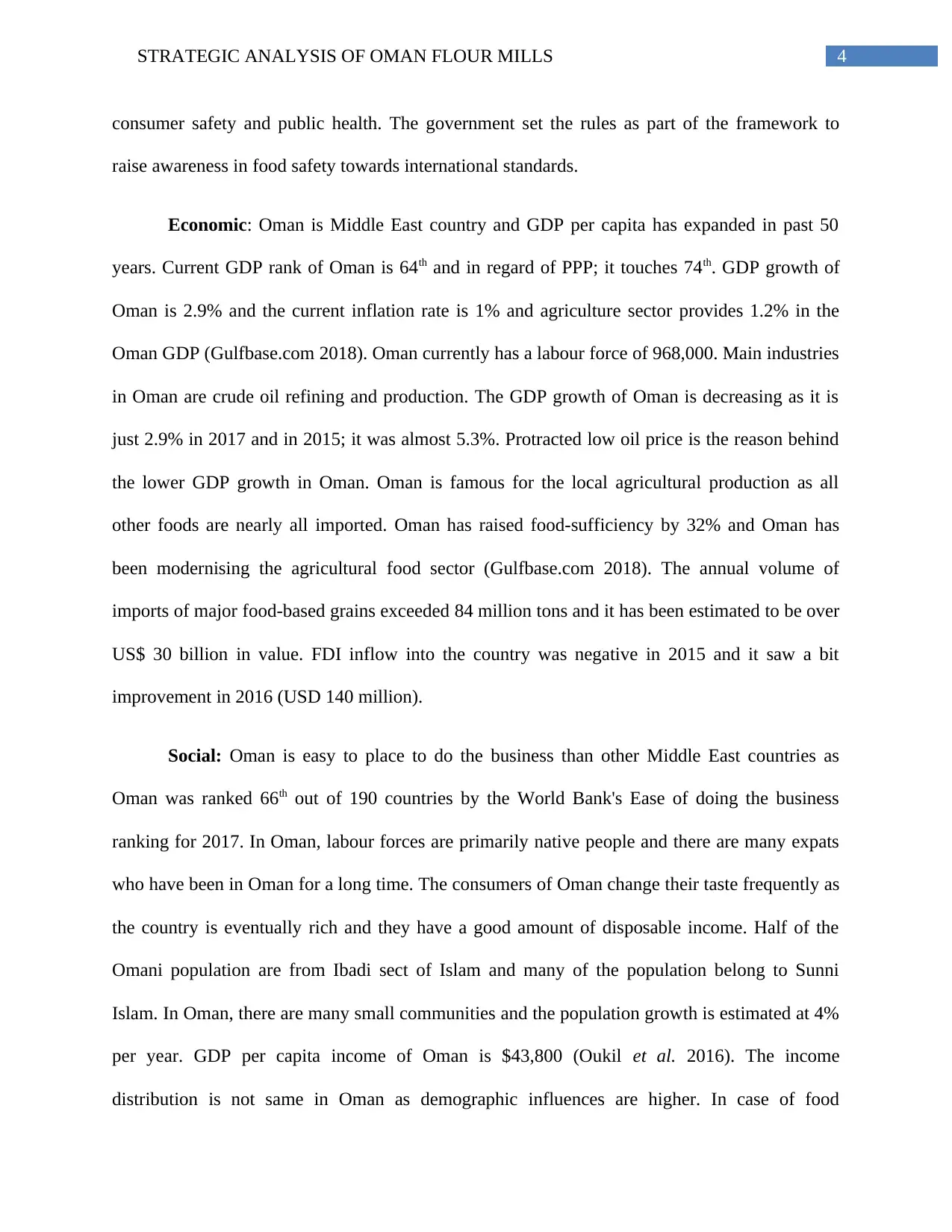
4STRATEGIC ANALYSIS OF OMAN FLOUR MILLS
consumer safety and public health. The government set the rules as part of the framework to
raise awareness in food safety towards international standards.
Economic: Oman is Middle East country and GDP per capita has expanded in past 50
years. Current GDP rank of Oman is 64th and in regard of PPP; it touches 74th. GDP growth of
Oman is 2.9% and the current inflation rate is 1% and agriculture sector provides 1.2% in the
Oman GDP (Gulfbase.com 2018). Oman currently has a labour force of 968,000. Main industries
in Oman are crude oil refining and production. The GDP growth of Oman is decreasing as it is
just 2.9% in 2017 and in 2015; it was almost 5.3%. Protracted low oil price is the reason behind
the lower GDP growth in Oman. Oman is famous for the local agricultural production as all
other foods are nearly all imported. Oman has raised food-sufficiency by 32% and Oman has
been modernising the agricultural food sector (Gulfbase.com 2018). The annual volume of
imports of major food-based grains exceeded 84 million tons and it has been estimated to be over
US$ 30 billion in value. FDI inflow into the country was negative in 2015 and it saw a bit
improvement in 2016 (USD 140 million).
Social: Oman is easy to place to do the business than other Middle East countries as
Oman was ranked 66th out of 190 countries by the World Bank's Ease of doing the business
ranking for 2017. In Oman, labour forces are primarily native people and there are many expats
who have been in Oman for a long time. The consumers of Oman change their taste frequently as
the country is eventually rich and they have a good amount of disposable income. Half of the
Omani population are from Ibadi sect of Islam and many of the population belong to Sunni
Islam. In Oman, there are many small communities and the population growth is estimated at 4%
per year. GDP per capita income of Oman is $43,800 (Oukil et al. 2016). The income
distribution is not same in Oman as demographic influences are higher. In case of food
consumer safety and public health. The government set the rules as part of the framework to
raise awareness in food safety towards international standards.
Economic: Oman is Middle East country and GDP per capita has expanded in past 50
years. Current GDP rank of Oman is 64th and in regard of PPP; it touches 74th. GDP growth of
Oman is 2.9% and the current inflation rate is 1% and agriculture sector provides 1.2% in the
Oman GDP (Gulfbase.com 2018). Oman currently has a labour force of 968,000. Main industries
in Oman are crude oil refining and production. The GDP growth of Oman is decreasing as it is
just 2.9% in 2017 and in 2015; it was almost 5.3%. Protracted low oil price is the reason behind
the lower GDP growth in Oman. Oman is famous for the local agricultural production as all
other foods are nearly all imported. Oman has raised food-sufficiency by 32% and Oman has
been modernising the agricultural food sector (Gulfbase.com 2018). The annual volume of
imports of major food-based grains exceeded 84 million tons and it has been estimated to be over
US$ 30 billion in value. FDI inflow into the country was negative in 2015 and it saw a bit
improvement in 2016 (USD 140 million).
Social: Oman is easy to place to do the business than other Middle East countries as
Oman was ranked 66th out of 190 countries by the World Bank's Ease of doing the business
ranking for 2017. In Oman, labour forces are primarily native people and there are many expats
who have been in Oman for a long time. The consumers of Oman change their taste frequently as
the country is eventually rich and they have a good amount of disposable income. Half of the
Omani population are from Ibadi sect of Islam and many of the population belong to Sunni
Islam. In Oman, there are many small communities and the population growth is estimated at 4%
per year. GDP per capita income of Oman is $43,800 (Oukil et al. 2016). The income
distribution is not same in Oman as demographic influences are higher. In case of food
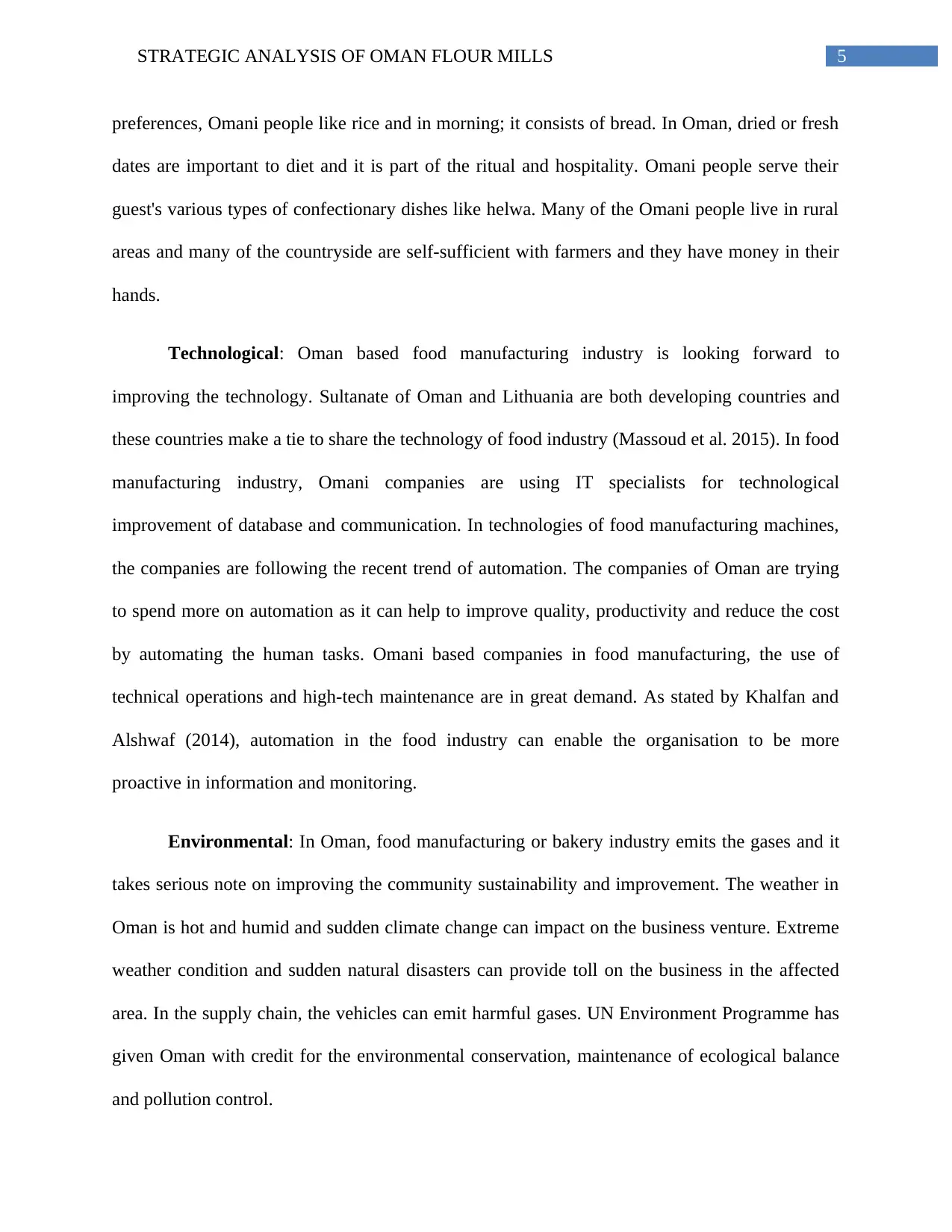
5STRATEGIC ANALYSIS OF OMAN FLOUR MILLS
preferences, Omani people like rice and in morning; it consists of bread. In Oman, dried or fresh
dates are important to diet and it is part of the ritual and hospitality. Omani people serve their
guest's various types of confectionary dishes like helwa. Many of the Omani people live in rural
areas and many of the countryside are self-sufficient with farmers and they have money in their
hands.
Technological: Oman based food manufacturing industry is looking forward to
improving the technology. Sultanate of Oman and Lithuania are both developing countries and
these countries make a tie to share the technology of food industry (Massoud et al. 2015). In food
manufacturing industry, Omani companies are using IT specialists for technological
improvement of database and communication. In technologies of food manufacturing machines,
the companies are following the recent trend of automation. The companies of Oman are trying
to spend more on automation as it can help to improve quality, productivity and reduce the cost
by automating the human tasks. Omani based companies in food manufacturing, the use of
technical operations and high-tech maintenance are in great demand. As stated by Khalfan and
Alshwaf (2014), automation in the food industry can enable the organisation to be more
proactive in information and monitoring.
Environmental: In Oman, food manufacturing or bakery industry emits the gases and it
takes serious note on improving the community sustainability and improvement. The weather in
Oman is hot and humid and sudden climate change can impact on the business venture. Extreme
weather condition and sudden natural disasters can provide toll on the business in the affected
area. In the supply chain, the vehicles can emit harmful gases. UN Environment Programme has
given Oman with credit for the environmental conservation, maintenance of ecological balance
and pollution control.
preferences, Omani people like rice and in morning; it consists of bread. In Oman, dried or fresh
dates are important to diet and it is part of the ritual and hospitality. Omani people serve their
guest's various types of confectionary dishes like helwa. Many of the Omani people live in rural
areas and many of the countryside are self-sufficient with farmers and they have money in their
hands.
Technological: Oman based food manufacturing industry is looking forward to
improving the technology. Sultanate of Oman and Lithuania are both developing countries and
these countries make a tie to share the technology of food industry (Massoud et al. 2015). In food
manufacturing industry, Omani companies are using IT specialists for technological
improvement of database and communication. In technologies of food manufacturing machines,
the companies are following the recent trend of automation. The companies of Oman are trying
to spend more on automation as it can help to improve quality, productivity and reduce the cost
by automating the human tasks. Omani based companies in food manufacturing, the use of
technical operations and high-tech maintenance are in great demand. As stated by Khalfan and
Alshwaf (2014), automation in the food industry can enable the organisation to be more
proactive in information and monitoring.
Environmental: In Oman, food manufacturing or bakery industry emits the gases and it
takes serious note on improving the community sustainability and improvement. The weather in
Oman is hot and humid and sudden climate change can impact on the business venture. Extreme
weather condition and sudden natural disasters can provide toll on the business in the affected
area. In the supply chain, the vehicles can emit harmful gases. UN Environment Programme has
given Oman with credit for the environmental conservation, maintenance of ecological balance
and pollution control.
⊘ This is a preview!⊘
Do you want full access?
Subscribe today to unlock all pages.

Trusted by 1+ million students worldwide
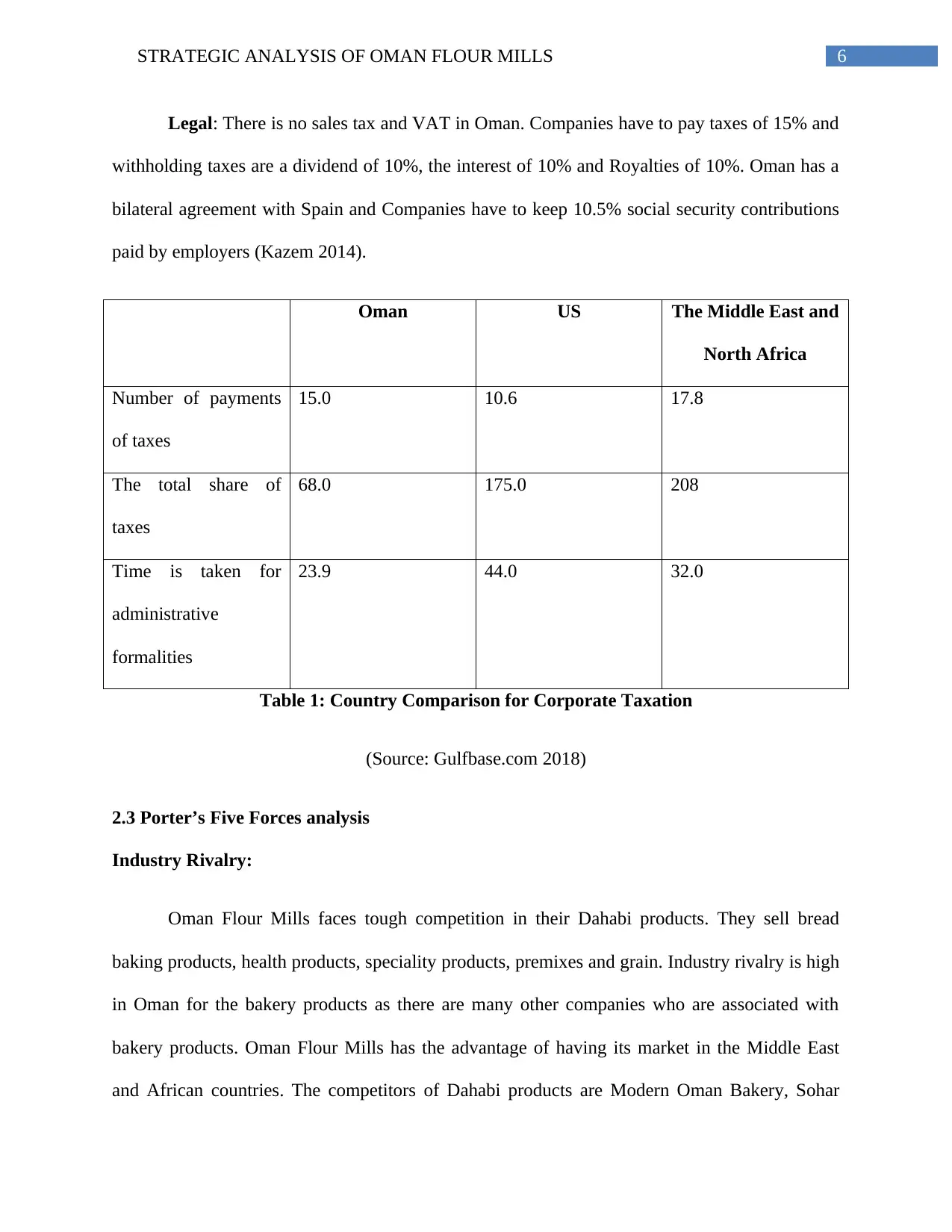
6STRATEGIC ANALYSIS OF OMAN FLOUR MILLS
Legal: There is no sales tax and VAT in Oman. Companies have to pay taxes of 15% and
withholding taxes are a dividend of 10%, the interest of 10% and Royalties of 10%. Oman has a
bilateral agreement with Spain and Companies have to keep 10.5% social security contributions
paid by employers (Kazem 2014).
Oman US The Middle East and
North Africa
Number of payments
of taxes
15.0 10.6 17.8
The total share of
taxes
68.0 175.0 208
Time is taken for
administrative
formalities
23.9 44.0 32.0
Table 1: Country Comparison for Corporate Taxation
(Source: Gulfbase.com 2018)
2.3 Porter’s Five Forces analysis
Industry Rivalry:
Oman Flour Mills faces tough competition in their Dahabi products. They sell bread
baking products, health products, speciality products, premixes and grain. Industry rivalry is high
in Oman for the bakery products as there are many other companies who are associated with
bakery products. Oman Flour Mills has the advantage of having its market in the Middle East
and African countries. The competitors of Dahabi products are Modern Oman Bakery, Sohar
Legal: There is no sales tax and VAT in Oman. Companies have to pay taxes of 15% and
withholding taxes are a dividend of 10%, the interest of 10% and Royalties of 10%. Oman has a
bilateral agreement with Spain and Companies have to keep 10.5% social security contributions
paid by employers (Kazem 2014).
Oman US The Middle East and
North Africa
Number of payments
of taxes
15.0 10.6 17.8
The total share of
taxes
68.0 175.0 208
Time is taken for
administrative
formalities
23.9 44.0 32.0
Table 1: Country Comparison for Corporate Taxation
(Source: Gulfbase.com 2018)
2.3 Porter’s Five Forces analysis
Industry Rivalry:
Oman Flour Mills faces tough competition in their Dahabi products. They sell bread
baking products, health products, speciality products, premixes and grain. Industry rivalry is high
in Oman for the bakery products as there are many other companies who are associated with
bakery products. Oman Flour Mills has the advantage of having its market in the Middle East
and African countries. The competitors of Dahabi products are Modern Oman Bakery, Sohar
Paraphrase This Document
Need a fresh take? Get an instant paraphrase of this document with our AI Paraphraser
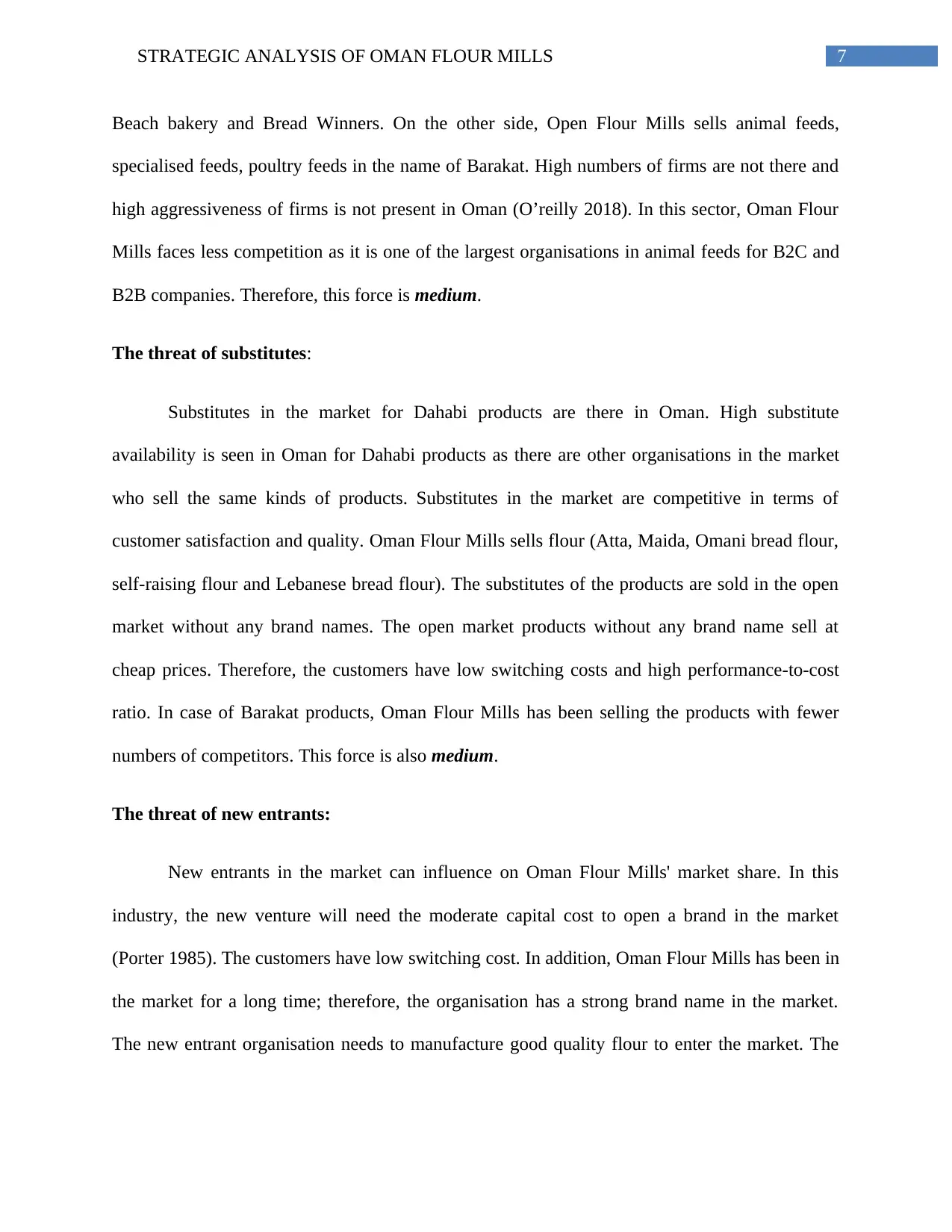
7STRATEGIC ANALYSIS OF OMAN FLOUR MILLS
Beach bakery and Bread Winners. On the other side, Open Flour Mills sells animal feeds,
specialised feeds, poultry feeds in the name of Barakat. High numbers of firms are not there and
high aggressiveness of firms is not present in Oman (O’reilly 2018). In this sector, Oman Flour
Mills faces less competition as it is one of the largest organisations in animal feeds for B2C and
B2B companies. Therefore, this force is medium.
The threat of substitutes:
Substitutes in the market for Dahabi products are there in Oman. High substitute
availability is seen in Oman for Dahabi products as there are other organisations in the market
who sell the same kinds of products. Substitutes in the market are competitive in terms of
customer satisfaction and quality. Oman Flour Mills sells flour (Atta, Maida, Omani bread flour,
self-raising flour and Lebanese bread flour). The substitutes of the products are sold in the open
market without any brand names. The open market products without any brand name sell at
cheap prices. Therefore, the customers have low switching costs and high performance-to-cost
ratio. In case of Barakat products, Oman Flour Mills has been selling the products with fewer
numbers of competitors. This force is also medium.
The threat of new entrants:
New entrants in the market can influence on Oman Flour Mills' market share. In this
industry, the new venture will need the moderate capital cost to open a brand in the market
(Porter 1985). The customers have low switching cost. In addition, Oman Flour Mills has been in
the market for a long time; therefore, the organisation has a strong brand name in the market.
The new entrant organisation needs to manufacture good quality flour to enter the market. The
Beach bakery and Bread Winners. On the other side, Open Flour Mills sells animal feeds,
specialised feeds, poultry feeds in the name of Barakat. High numbers of firms are not there and
high aggressiveness of firms is not present in Oman (O’reilly 2018). In this sector, Oman Flour
Mills faces less competition as it is one of the largest organisations in animal feeds for B2C and
B2B companies. Therefore, this force is medium.
The threat of substitutes:
Substitutes in the market for Dahabi products are there in Oman. High substitute
availability is seen in Oman for Dahabi products as there are other organisations in the market
who sell the same kinds of products. Substitutes in the market are competitive in terms of
customer satisfaction and quality. Oman Flour Mills sells flour (Atta, Maida, Omani bread flour,
self-raising flour and Lebanese bread flour). The substitutes of the products are sold in the open
market without any brand names. The open market products without any brand name sell at
cheap prices. Therefore, the customers have low switching costs and high performance-to-cost
ratio. In case of Barakat products, Oman Flour Mills has been selling the products with fewer
numbers of competitors. This force is also medium.
The threat of new entrants:
New entrants in the market can influence on Oman Flour Mills' market share. In this
industry, the new venture will need the moderate capital cost to open a brand in the market
(Porter 1985). The customers have low switching cost. In addition, Oman Flour Mills has been in
the market for a long time; therefore, the organisation has a strong brand name in the market.
The new entrant organisation needs to manufacture good quality flour to enter the market. The
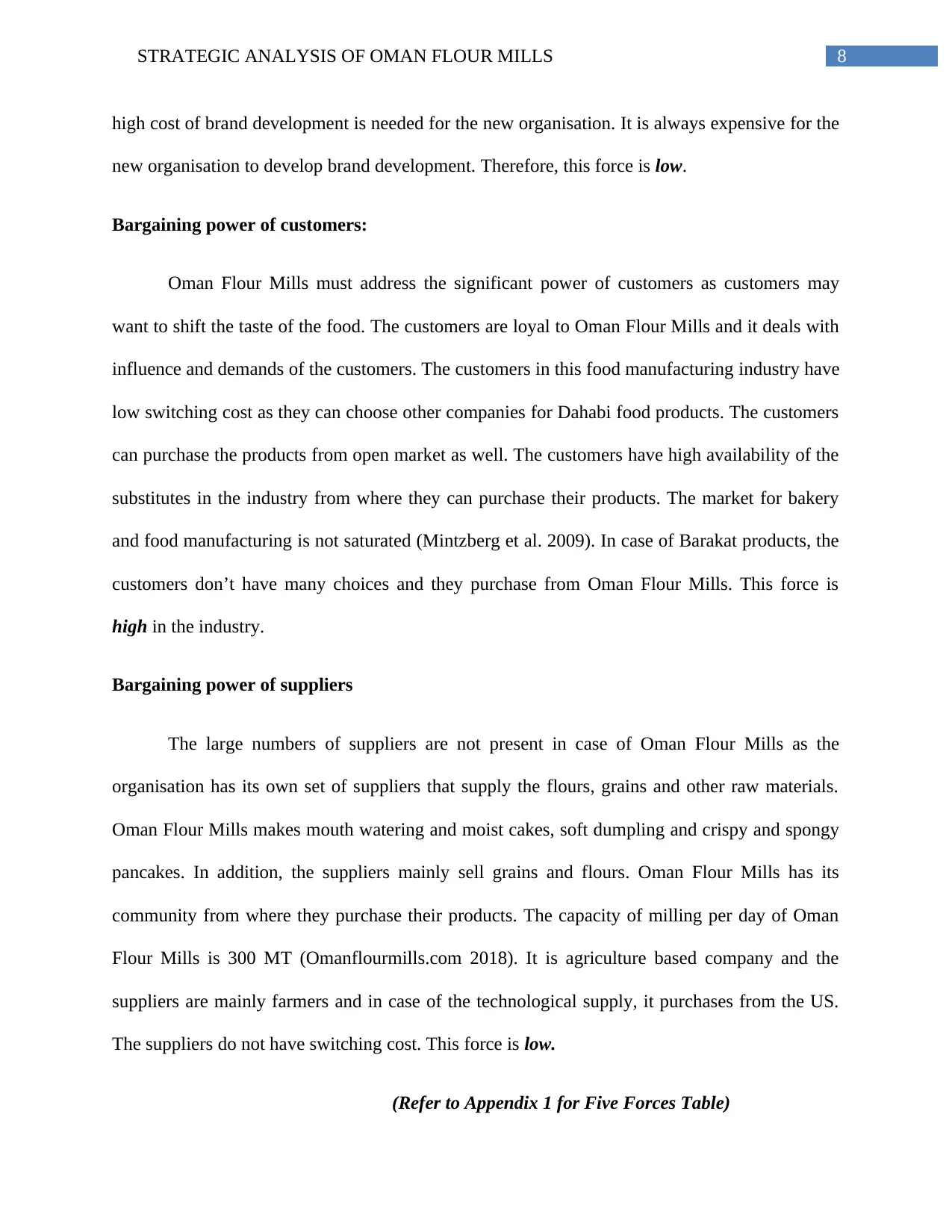
8STRATEGIC ANALYSIS OF OMAN FLOUR MILLS
high cost of brand development is needed for the new organisation. It is always expensive for the
new organisation to develop brand development. Therefore, this force is low.
Bargaining power of customers:
Oman Flour Mills must address the significant power of customers as customers may
want to shift the taste of the food. The customers are loyal to Oman Flour Mills and it deals with
influence and demands of the customers. The customers in this food manufacturing industry have
low switching cost as they can choose other companies for Dahabi food products. The customers
can purchase the products from open market as well. The customers have high availability of the
substitutes in the industry from where they can purchase their products. The market for bakery
and food manufacturing is not saturated (Mintzberg et al. 2009). In case of Barakat products, the
customers don’t have many choices and they purchase from Oman Flour Mills. This force is
high in the industry.
Bargaining power of suppliers
The large numbers of suppliers are not present in case of Oman Flour Mills as the
organisation has its own set of suppliers that supply the flours, grains and other raw materials.
Oman Flour Mills makes mouth watering and moist cakes, soft dumpling and crispy and spongy
pancakes. In addition, the suppliers mainly sell grains and flours. Oman Flour Mills has its
community from where they purchase their products. The capacity of milling per day of Oman
Flour Mills is 300 MT (Omanflourmills.com 2018). It is agriculture based company and the
suppliers are mainly farmers and in case of the technological supply, it purchases from the US.
The suppliers do not have switching cost. This force is low.
(Refer to Appendix 1 for Five Forces Table)
high cost of brand development is needed for the new organisation. It is always expensive for the
new organisation to develop brand development. Therefore, this force is low.
Bargaining power of customers:
Oman Flour Mills must address the significant power of customers as customers may
want to shift the taste of the food. The customers are loyal to Oman Flour Mills and it deals with
influence and demands of the customers. The customers in this food manufacturing industry have
low switching cost as they can choose other companies for Dahabi food products. The customers
can purchase the products from open market as well. The customers have high availability of the
substitutes in the industry from where they can purchase their products. The market for bakery
and food manufacturing is not saturated (Mintzberg et al. 2009). In case of Barakat products, the
customers don’t have many choices and they purchase from Oman Flour Mills. This force is
high in the industry.
Bargaining power of suppliers
The large numbers of suppliers are not present in case of Oman Flour Mills as the
organisation has its own set of suppliers that supply the flours, grains and other raw materials.
Oman Flour Mills makes mouth watering and moist cakes, soft dumpling and crispy and spongy
pancakes. In addition, the suppliers mainly sell grains and flours. Oman Flour Mills has its
community from where they purchase their products. The capacity of milling per day of Oman
Flour Mills is 300 MT (Omanflourmills.com 2018). It is agriculture based company and the
suppliers are mainly farmers and in case of the technological supply, it purchases from the US.
The suppliers do not have switching cost. This force is low.
(Refer to Appendix 1 for Five Forces Table)
⊘ This is a preview!⊘
Do you want full access?
Subscribe today to unlock all pages.

Trusted by 1+ million students worldwide
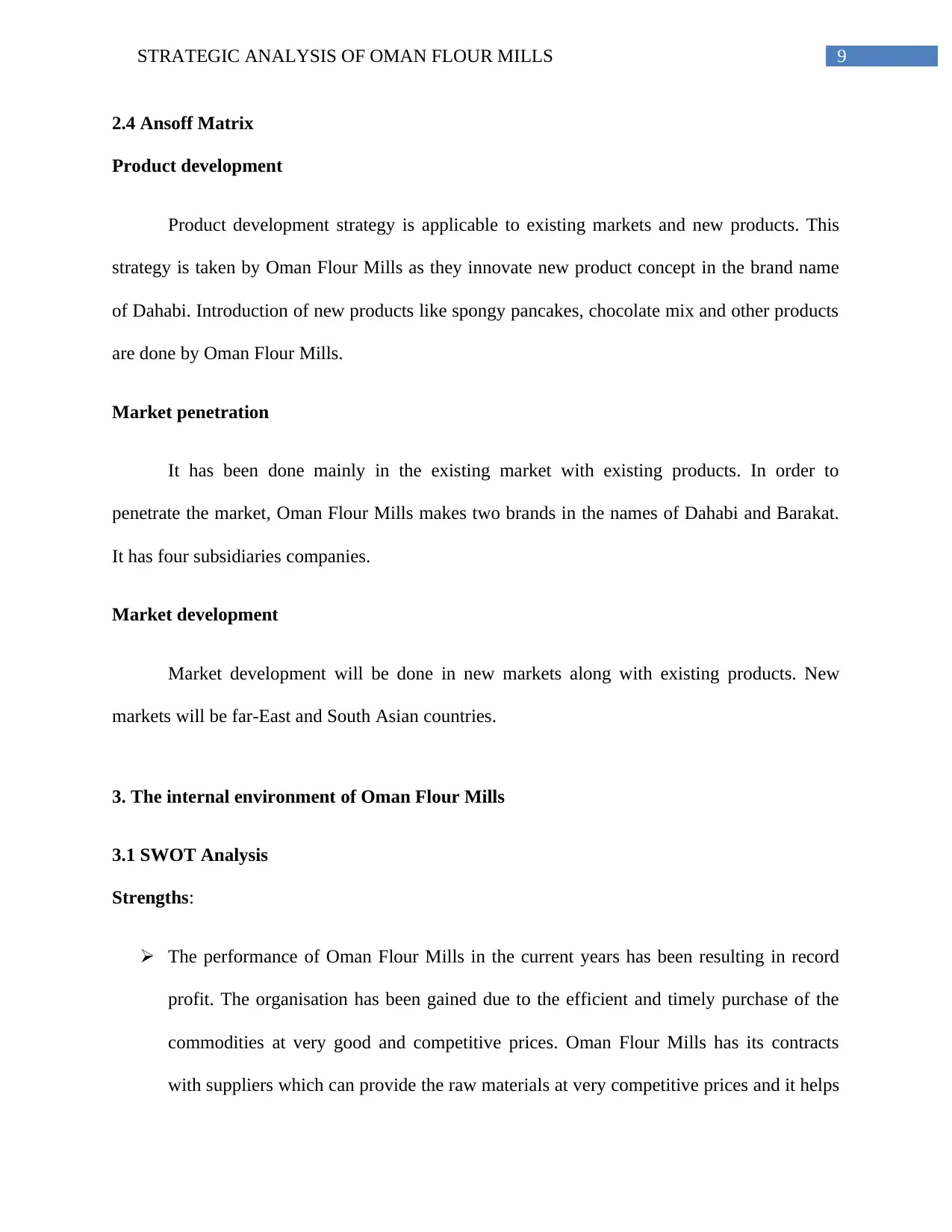
9STRATEGIC ANALYSIS OF OMAN FLOUR MILLS
2.4 Ansoff Matrix
Product development
Product development strategy is applicable to existing markets and new products. This
strategy is taken by Oman Flour Mills as they innovate new product concept in the brand name
of Dahabi. Introduction of new products like spongy pancakes, chocolate mix and other products
are done by Oman Flour Mills.
Market penetration
It has been done mainly in the existing market with existing products. In order to
penetrate the market, Oman Flour Mills makes two brands in the names of Dahabi and Barakat.
It has four subsidiaries companies.
Market development
Market development will be done in new markets along with existing products. New
markets will be far-East and South Asian countries.
3. The internal environment of Oman Flour Mills
3.1 SWOT Analysis
Strengths:
The performance of Oman Flour Mills in the current years has been resulting in record
profit. The organisation has been gained due to the efficient and timely purchase of the
commodities at very good and competitive prices. Oman Flour Mills has its contracts
with suppliers which can provide the raw materials at very competitive prices and it helps
2.4 Ansoff Matrix
Product development
Product development strategy is applicable to existing markets and new products. This
strategy is taken by Oman Flour Mills as they innovate new product concept in the brand name
of Dahabi. Introduction of new products like spongy pancakes, chocolate mix and other products
are done by Oman Flour Mills.
Market penetration
It has been done mainly in the existing market with existing products. In order to
penetrate the market, Oman Flour Mills makes two brands in the names of Dahabi and Barakat.
It has four subsidiaries companies.
Market development
Market development will be done in new markets along with existing products. New
markets will be far-East and South Asian countries.
3. The internal environment of Oman Flour Mills
3.1 SWOT Analysis
Strengths:
The performance of Oman Flour Mills in the current years has been resulting in record
profit. The organisation has been gained due to the efficient and timely purchase of the
commodities at very good and competitive prices. Oman Flour Mills has its contracts
with suppliers which can provide the raw materials at very competitive prices and it helps
Paraphrase This Document
Need a fresh take? Get an instant paraphrase of this document with our AI Paraphraser
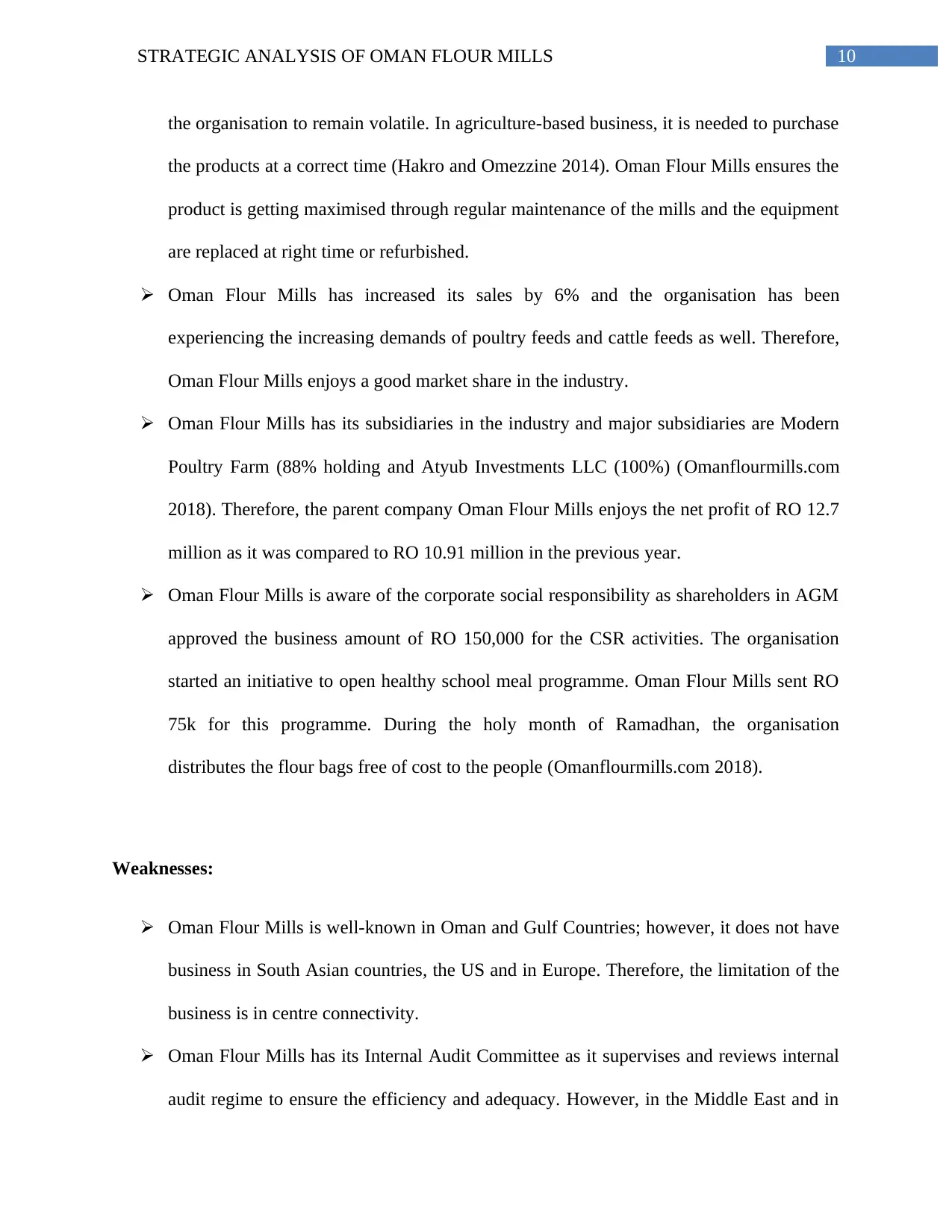
10STRATEGIC ANALYSIS OF OMAN FLOUR MILLS
the organisation to remain volatile. In agriculture-based business, it is needed to purchase
the products at a correct time (Hakro and Omezzine 2014). Oman Flour Mills ensures the
product is getting maximised through regular maintenance of the mills and the equipment
are replaced at right time or refurbished.
Oman Flour Mills has increased its sales by 6% and the organisation has been
experiencing the increasing demands of poultry feeds and cattle feeds as well. Therefore,
Oman Flour Mills enjoys a good market share in the industry.
Oman Flour Mills has its subsidiaries in the industry and major subsidiaries are Modern
Poultry Farm (88% holding and Atyub Investments LLC (100%) (Omanflourmills.com
2018). Therefore, the parent company Oman Flour Mills enjoys the net profit of RO 12.7
million as it was compared to RO 10.91 million in the previous year.
Oman Flour Mills is aware of the corporate social responsibility as shareholders in AGM
approved the business amount of RO 150,000 for the CSR activities. The organisation
started an initiative to open healthy school meal programme. Oman Flour Mills sent RO
75k for this programme. During the holy month of Ramadhan, the organisation
distributes the flour bags free of cost to the people (Omanflourmills.com 2018).
Weaknesses:
Oman Flour Mills is well-known in Oman and Gulf Countries; however, it does not have
business in South Asian countries, the US and in Europe. Therefore, the limitation of the
business is in centre connectivity.
Oman Flour Mills has its Internal Audit Committee as it supervises and reviews internal
audit regime to ensure the efficiency and adequacy. However, in the Middle East and in
the organisation to remain volatile. In agriculture-based business, it is needed to purchase
the products at a correct time (Hakro and Omezzine 2014). Oman Flour Mills ensures the
product is getting maximised through regular maintenance of the mills and the equipment
are replaced at right time or refurbished.
Oman Flour Mills has increased its sales by 6% and the organisation has been
experiencing the increasing demands of poultry feeds and cattle feeds as well. Therefore,
Oman Flour Mills enjoys a good market share in the industry.
Oman Flour Mills has its subsidiaries in the industry and major subsidiaries are Modern
Poultry Farm (88% holding and Atyub Investments LLC (100%) (Omanflourmills.com
2018). Therefore, the parent company Oman Flour Mills enjoys the net profit of RO 12.7
million as it was compared to RO 10.91 million in the previous year.
Oman Flour Mills is aware of the corporate social responsibility as shareholders in AGM
approved the business amount of RO 150,000 for the CSR activities. The organisation
started an initiative to open healthy school meal programme. Oman Flour Mills sent RO
75k for this programme. During the holy month of Ramadhan, the organisation
distributes the flour bags free of cost to the people (Omanflourmills.com 2018).
Weaknesses:
Oman Flour Mills is well-known in Oman and Gulf Countries; however, it does not have
business in South Asian countries, the US and in Europe. Therefore, the limitation of the
business is in centre connectivity.
Oman Flour Mills has its Internal Audit Committee as it supervises and reviews internal
audit regime to ensure the efficiency and adequacy. However, in the Middle East and in
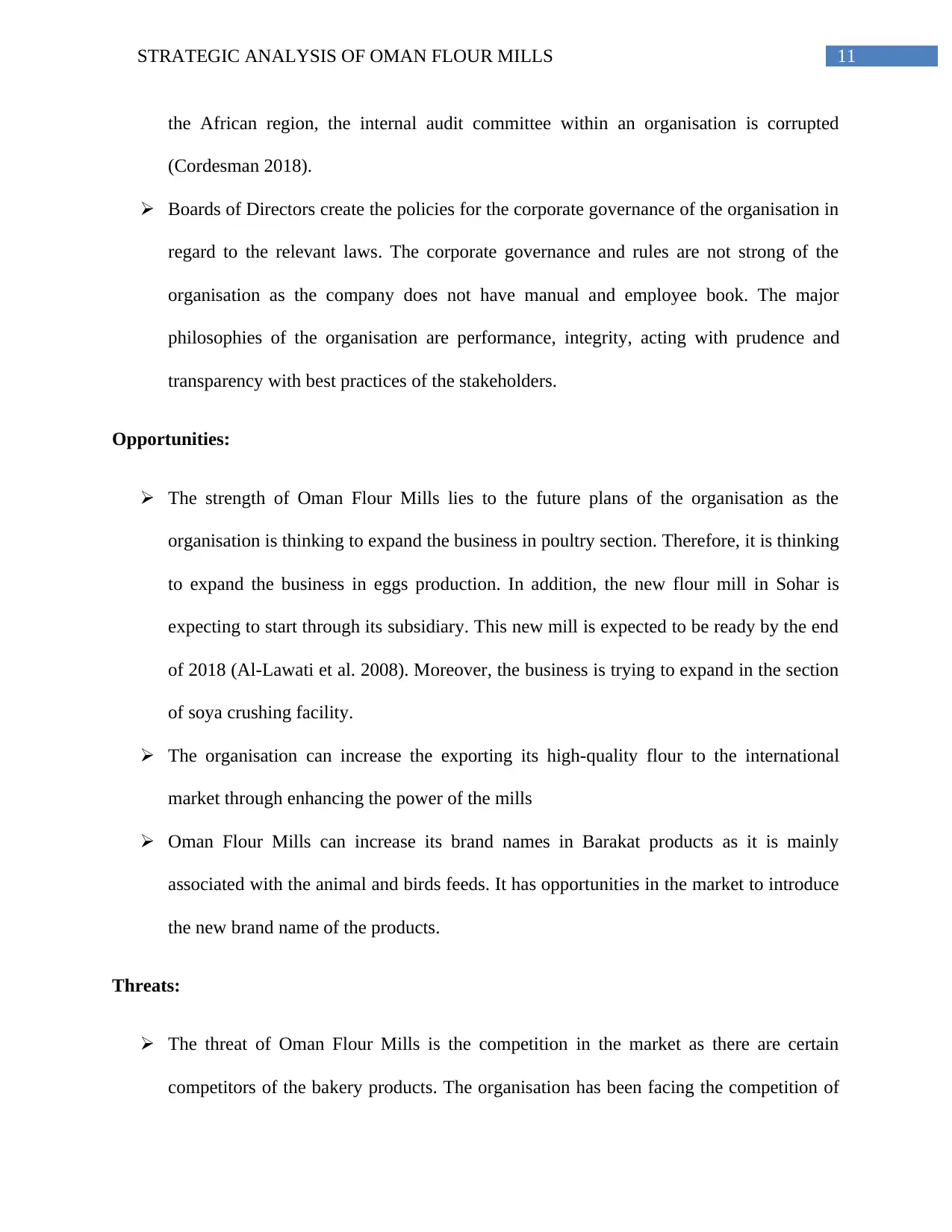
11STRATEGIC ANALYSIS OF OMAN FLOUR MILLS
the African region, the internal audit committee within an organisation is corrupted
(Cordesman 2018).
Boards of Directors create the policies for the corporate governance of the organisation in
regard to the relevant laws. The corporate governance and rules are not strong of the
organisation as the company does not have manual and employee book. The major
philosophies of the organisation are performance, integrity, acting with prudence and
transparency with best practices of the stakeholders.
Opportunities:
The strength of Oman Flour Mills lies to the future plans of the organisation as the
organisation is thinking to expand the business in poultry section. Therefore, it is thinking
to expand the business in eggs production. In addition, the new flour mill in Sohar is
expecting to start through its subsidiary. This new mill is expected to be ready by the end
of 2018 (Al-Lawati et al. 2008). Moreover, the business is trying to expand in the section
of soya crushing facility.
The organisation can increase the exporting its high-quality flour to the international
market through enhancing the power of the mills
Oman Flour Mills can increase its brand names in Barakat products as it is mainly
associated with the animal and birds feeds. It has opportunities in the market to introduce
the new brand name of the products.
Threats:
The threat of Oman Flour Mills is the competition in the market as there are certain
competitors of the bakery products. The organisation has been facing the competition of
the African region, the internal audit committee within an organisation is corrupted
(Cordesman 2018).
Boards of Directors create the policies for the corporate governance of the organisation in
regard to the relevant laws. The corporate governance and rules are not strong of the
organisation as the company does not have manual and employee book. The major
philosophies of the organisation are performance, integrity, acting with prudence and
transparency with best practices of the stakeholders.
Opportunities:
The strength of Oman Flour Mills lies to the future plans of the organisation as the
organisation is thinking to expand the business in poultry section. Therefore, it is thinking
to expand the business in eggs production. In addition, the new flour mill in Sohar is
expecting to start through its subsidiary. This new mill is expected to be ready by the end
of 2018 (Al-Lawati et al. 2008). Moreover, the business is trying to expand in the section
of soya crushing facility.
The organisation can increase the exporting its high-quality flour to the international
market through enhancing the power of the mills
Oman Flour Mills can increase its brand names in Barakat products as it is mainly
associated with the animal and birds feeds. It has opportunities in the market to introduce
the new brand name of the products.
Threats:
The threat of Oman Flour Mills is the competition in the market as there are certain
competitors of the bakery products. The organisation has been facing the competition of
⊘ This is a preview!⊘
Do you want full access?
Subscribe today to unlock all pages.

Trusted by 1+ million students worldwide
1 out of 24
Related Documents
Your All-in-One AI-Powered Toolkit for Academic Success.
+13062052269
info@desklib.com
Available 24*7 on WhatsApp / Email
![[object Object]](/_next/static/media/star-bottom.7253800d.svg)
Unlock your academic potential
Copyright © 2020–2025 A2Z Services. All Rights Reserved. Developed and managed by ZUCOL.





